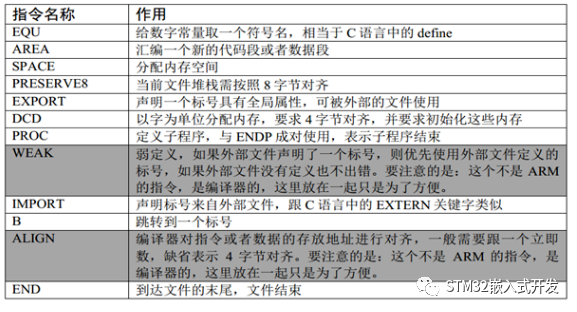一、概述
-
目标:培养正规、大气的编程习惯;学习面向对象设计
-
Object Based(基于对象):以良好的方式编写C++class
- class without pointer members【示例:Complex类】
- class with pointer members【示例:String类】
-
Object Oriented(面向对象):学习Classes之间的关系
- 继承(inheritance)
- 复合(composition)
- 委托(delegation)
-
-
推荐书籍
《C++11 Primer》
《The C++ Programming Language》
《Effective C++》
《Effective C++ Third Edition》
二、Object Based(基于对象):以良好的方式编写C++class
1.Complex类:class without pointer members
总结:设计一个好的类需要注意:
- 构造函数尽量使用初始化列
- 成员函数尽量使用常函数
- 函数参数的传递尽量使用【引用】,尽量使用【const】修饰
- 函数返回值在可以的情况下,尽量使用【引用】
- 成员变量尽量放到private中,函数绝大部分放到public中
#ifndef __COMPLEX__//1.Header(头文件)中的防卫声明
#define __COMPLEX__
#include<iostream>
using namespace std;
//<<<<<<<<<<<<<<<<<<<<<<<<布局1:前置声明(forward declarations)<<<<<<<<<<<<<<<<<<<<<<<<
//<<<<<<<<<<<<<<<<<<<<<<<<布局2:类-声明(class declarations)<<<<<<<<<<<<<<<<<<<<<<<
class complex
{
/**
* 2.函数(构造函数或成员函数)
* a. 若在class body内定义完成,便自动成为【inline】候选人
* b. 成员函数都有隐藏的this指针
*/
public://3.访问级别
/**
* 4.构造函数:
* a. 考虑添加使用默认实参
* b. 尽量使用初始化列(initialization list),而不使用赋值(assignments)
* 注意:赋值会比初始化效率差一些
* c. 构造函数可以重载
* 注意:complex():re(0),im(0){} 这个构造函数和下边的构造函数重载冲突
* d. 特殊使用:把构造函数放到private中,单例模式
* */
complex(double r=0, double i=0)
: re(r), im(i)//初始化列表
{}
/**
* 5.const member function(常函数): 在函数后边加const
* 常对象只能调用常函数:
* 注意:不改变数据内容的都“必须”加上const
* 如果没有加,在用户将complex设置为常对象(说明对象不能改变数据)时,
* 但是没有将用户调用的函数设置为常函数(说明这个函数可以改变),
* 这是矛盾的,编译器会报错!!!
*
* 6.参数传递:(pass by value vs. pass by reference - to const)
* a.使用优先级:引用>指针>值(尽量使用引用,引用比指针更大气),可以提高效率
* b.尽量加const:不改变参数
*
* 7. 返回值传递:(return by value vs. return by reference - to const)
* 尽量使用引用:传递者无需知道接收者是以reference形式接收
* 例如_doapl函数:这里返回的是object(传递者),但是返回值类型是引用(接收者)
*
*/
double real() const {return re;}//定义
double imag() const {return im;}
/**
* 9. 操作符重载+=(成员函数、二元操作符)
* 会将this隐藏掉【complex& operator+=(this,const complex&);】
* c3+=(c2=+c1):连串使用操作符时,需要考虑返回值是【引用】
*/
complex& operator+=(/*this,*/const complex&);//声明
private:
double re, im;
/**
* 8. 友元函数:可以自由取得private成员
* 注意:相同类的对象可以互相访问私有成员【相同类的各个对象互为友元】
*/
friend complex& _doapl(complex*, const complex&);
};
//<<<<<<<<<<<<<<<<<<<<<<<<布局3:类-定义(class definition)<<<<<<<<<<<<<<<<<<<<<<<<<<<<<<<<<<
inline complex&
_doapl(complex* ths, const complex& r)
{
ths->re += r.re;
ths->im += r.im;
return *ths;
}
//<<<<<<<<<<<<<<<<<<<<<<<<布局4:全局函数<<<<<<<<<<<<<<<<<<<<<<<<<<<<<<<<<<
inline double
imag(const complex& x)
{
return x.imag();
}
inline double
real(const complex& x)
{
return x.real();
}
/**
* 9. 操作符重载+(二元操作符,非成员函数【无this】)
* 注意:这个重载的返回值绝不能是reference,因为返回的必定是local object;
* 尽量将这个重载声明为非成员函数:因为成员函数重载,可能会限制参数传递
*
* 10. temp object(临时对象)--> typename();
* 示例:complex(real(x) + real(y), imag(x)+imag(y));
*/
inline complex
operator+ (const complex& x, const complex& y)
{
return complex(real(x) + real(y), imag(x)+imag(y));
}
inline complex
operator+ (const complex& x, double& y)
{
return complex(real(x) + y, imag(x)+y);
}
inline complex
operator+ (double& x, const complex& y)
{
return complex(x + real(y), x+imag(y));
}
/**
* 9.重载运算符+和-(正负、一元运算符、非成员函数)
* 注意:+重载的返回值不能使用reference,因为返回值绑定的是const类型
* -重载的返回值不能使用reference,因为返回值必定是local object
*
*/
inline complex
operator+(const complex& x)
{
return x;
}
inline complex
operator-(const complex& x)
{
return complex(-real(x), -imag(x));
}
/**
* cout << c1 << c2;
* 9.重载运算符<<(二元运算符只会把结果作用的运算符左侧变量)
* 注意:【只能是非成员函数】:因为这里的os对象不认识complex,无法使用this指针识别os对象;
* 参数:os对象前不能使用const修饰:因为os对象会被修改;
* 返回值:不能返回void:因为可能会连串使用操作符<<
*
*/
inline ostream&
operator<< (ostream& os, const complex& x)
{
return os << '(' << real(x) << ',' << imag(x) << ')';
}
#endif
2.String类:class with pointer members
//String.h
#ifndef __MY_STRING_H__
#define __MY_STRING_H__
#include <string.h>
#include <iostream>
using namespace std;
class String
{
public:
String(const char* cstr = 0);
String(const String& str);//copy ctor-----》String s2(s1) String s2 = s1
String& operator=(const String& str);//copy op= --------》 s2 = s1
~String();
char* get_c_str() const{return m_data;}
private:
char* m_data;
};
inline
String::String(const char* cstr)
{
if(cstr)
{
cout << "String::String(const char* cstr = 0)1" << endl;
m_data = new char[strlen(cstr) + 1];
strcpy(m_data,cstr);
}
else
{//注意1:未指定初值:默认构造函数
cout << "String::String(const char* cstr = 0)2" << endl;
m_data = new char[1];
*m_data = '\0';
}
}
inline
String::String(const String& str)
{
cout << "拷贝构造函数" << endl;
m_data = new char[strlen(str.m_data) + 1];
strcpy(this->m_data,str.m_data);
}
inline
String& String::operator=(const String& str)
{
cout << "拷贝赋值函数" << endl;
if(this == &str)//注意2:自我检测赋值(自己赋值自己):如果没有这一步,下边的delete会把自身先杀掉
return *this;
delete[] m_data;//注意3:需要先把之前的指向的内存释放掉
m_data = new char[strlen(str.m_data) + 1];
strcpy(this->m_data,str.m_data);
return *this;
}
inline ostream&
operator<<(ostream& os, const String& str)
{
return os << str.get_c_str();
}
inline
String::~String()
{
delete[] m_data;
}
#endif // !__MY_STRING_H__
3.补充:static–静态成员变量&静态成员函数
class Account
{
public:
// 1.static的作用:将成员变量和成员函数在类中独立出去;
static double m_rate;
static void set_rate(const double& x){m_rate = x;}
};
// 2.静态Data必须在类外定义(这里是在分配内存,上边只是声明),可以不用赋初值;
double Account::m_rate = 8.0;
int main()
{
// 3.两种调用方式:通过class那么调用、通过Object调用
Account::set_rate(5.0);
// 4.注意:通过Object调用,但是不会将对象地址当做参数this,函数体内不能使用this指针
Account a;
a.set_rate(7.0);
}
三、Object Oriented(面向对象):学习Classes之间的关系
1.复合(composition)表示has-a
a.什么是复合关系?
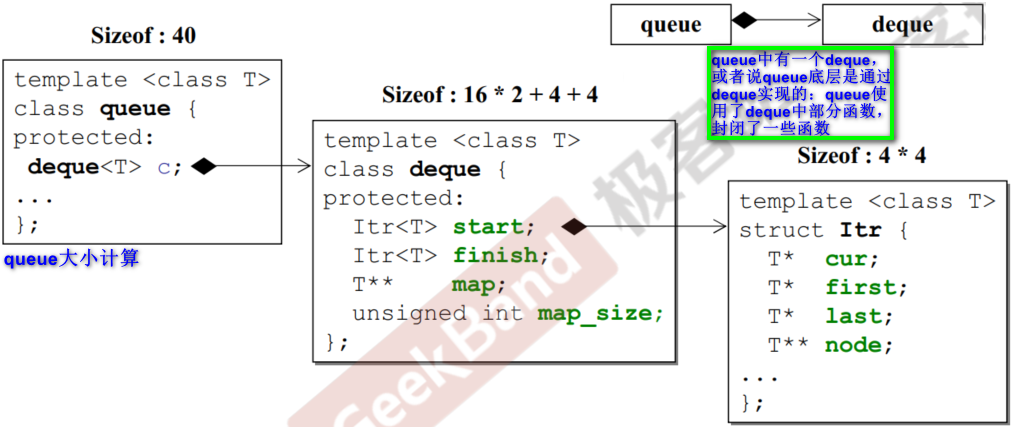
//Adapter
template <class T>
class queue
{
...
protected:
deque<T> c; //底层容器
public:
//以下都是利用c的操作函数完成的
bool empty() const {return c.empty();}
size_type size() const {return c.size();}
void push(const value_type & x){c.push_back(x);}
...
};
b.composition【复合】关系下的构造和析构(内存角度分析)

构造由内向外: container的构造函数首先调用component的default构造函数,后才执行自己
Container::Container(...) : Component() {...};
【注意】如果component需要参数,用户需要自己给构造函数
析构由外到内: container的析构函数首先执行自己,然后才调用component的析构函数
Container::~Container(...) {... ~Component()};
2.委托(Deletagion)–Composition by reference(pointer)
什么是委托关系?

// String.hpp---Handle---定义
class StringRep;
class String
{
public:
String();
String(const char* s);
String(const String& s);
String &operator= (const String& s);
~String();
...
private:
StringRep* rep;//pImpl-->通过指针实现函数定义
};
// String.cpp---Body---实现"background: aliceblue"
#include "String.hpp"
namespace
{
class StringRep
{
friend class String;
StringRep(const char* s);
~StringRep();
int count;
char* rep;
};
}
String::String(){...}
...
3.继承(Inheritance)–表示is-a
a.什么是继承关系?

struct _List_node_base
{
_List_node_base* _M_next;
_List_node_base* _M_prev;
};
template<typename _Tp>
struct _List_node
: public _List_node_base //public继承:这里只由数据的继承,父类没有函数
{
_Tp _M_data;
}
b.Inheritance(继承)关系下的构造和析构(从内存角度分析)
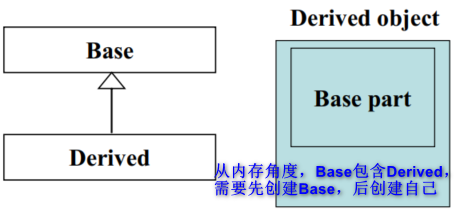
构造由内到外:Derived的构造函数首先调用Base的default构造函数,然后执行自己
Derived::Derived(...) : Base() {...};
析构由外到内:Derived的析构函数首先执行自己,然后才调用Base的析构函数
【注意】base class的dtor必须是virtual,否则会出现undefined behavior
Derived::~Derived(...) {... ~Base()};
c.Inheritance(继承)with virtual functions(虚函数)
继承需要搭配虚函数才能达到强有力的效果,在继承关系中,父类中所有的东西都会被继承下来:数据被继承下来,占用了内存的一部分,函数被继承下来, 是继承了调用权(子类可以调用父类的函数)
那么父类的函数,需不需要被重新定义呢?
从这个角度,父类的函数可以分为三种:
-
non-virtual函数(非虚函数):你不希望derived class重新定义(override,复写)它;
-
virtual函数(虚函数):你希望derived class重新定义(override)它,且你对它已有默认定义;
-
pure virtual函数(纯虚函数):你希望derived class一定要重新定义(override)它,你对它没有默认定义;(注:其实纯虚函数可以由定义)
形状(shape):世界上并没有叫形状的形状,只有椭圆等;形状是一个抽象的概念,那么可以在这个抽象的层次做些什么呢?(该如何思考呢?)
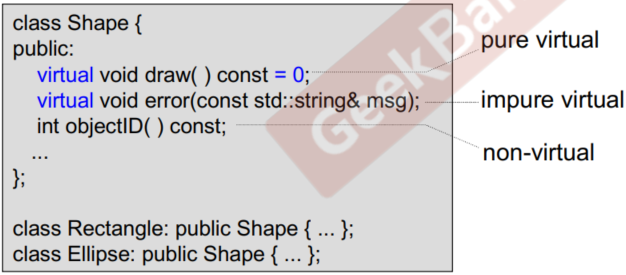
-
bjectID():在运行过程中,给每一个产生的对象一个ID,这个产生ID的过程,不管是椭圆还是方形,都是流水号,所以不需要让子类实现它,只需要父类定义它就可以了,那么把它定义为非虚函数
-
error():在执行过程中,可能会报错,设计的父类可以给一个默认的报错形式;但是在设计椭圆或方形时,可能不同的子类可以由更好的报错形式,父类允许子类重新定义error(),所以父类定义为虚函数
-
draw():这个必须要让所有的子类重新定义,因为父类不知道如何定义它,需要将它定义为纯虚函数
通过上述,可知继承要搭配虚函数才能达到最好的效果。
4.面向对象的几个应用(设计模式几种经典应用)
a.模板设计模式(Template Method)【Inheritance + virtual】
-
继承搭配虚函数使用:
-
场景:将关键执行部分延缓到子类中决定如何执行
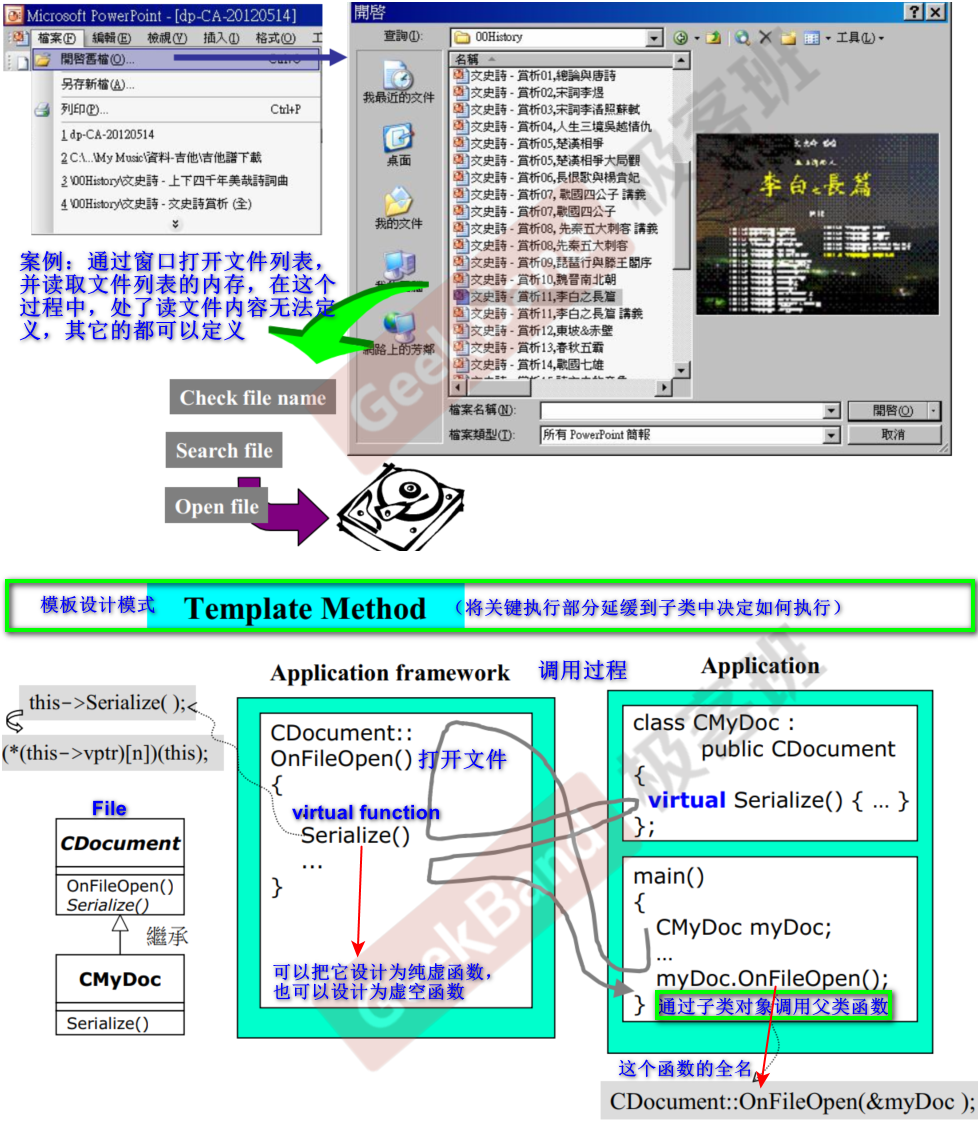
//模拟上边过程
#include<iostream>
using namespace std;
class CDocument
{
public:
void OnFileOpen()
{
//这是个算法,每个cout输出代表一个实际动作
cout << "dialog..." << endl;
cout << "check file status ..." << endl;
cout << "open file..." << endl;
Serialize();//调用
cout << "close file..." << endl;
cout << "update all views..." << endl;
}
virtual void Serialize() { };
};
//
class CMyDoc : public CDocument
{
public:
virtual void Serialize()
{
//只有应用程序本身才知道如何读取自己的文件(格式)
cout << "CMyDoc::Serialize()" << endl;
}
};
//
int main()
{
CMyDoc myDoc;//假设对应【File/Open】
myDoc.OnFileOpen();
}
b.从内存角度分析Inheritance+Composition关系下的构造和析构
- 继承搭配组合使用,分为两种情况:

第一种:Derived(子类)继承Base(父类),(子类)同时包含了Component类
-
从内存角度分析,Derived既有Base的成分,同时包含了Component
-
那么谁先分配内存呢?或者说谁的构造函数先被执行呢?
- Derived的构造函数首先调用Base的default构造函数,然后调用Component的default的构造函数,最后才执行自己
Derived::Derived(...) : Base(), Component() { ... };

第二种:Derived(子类)继承Base(父类),(父类)包含了Component
-
从内存角度分析,Derived继承了Base的成分,Base包含了Component
-
由内到外调用:先调用Component的default构造函数,再调用Base的default构造函数,最后调用Derived的构造函数。
c.观察者模式(Observer)【Delegation+Inheritance】
- 将继承和委托搭配起来使用
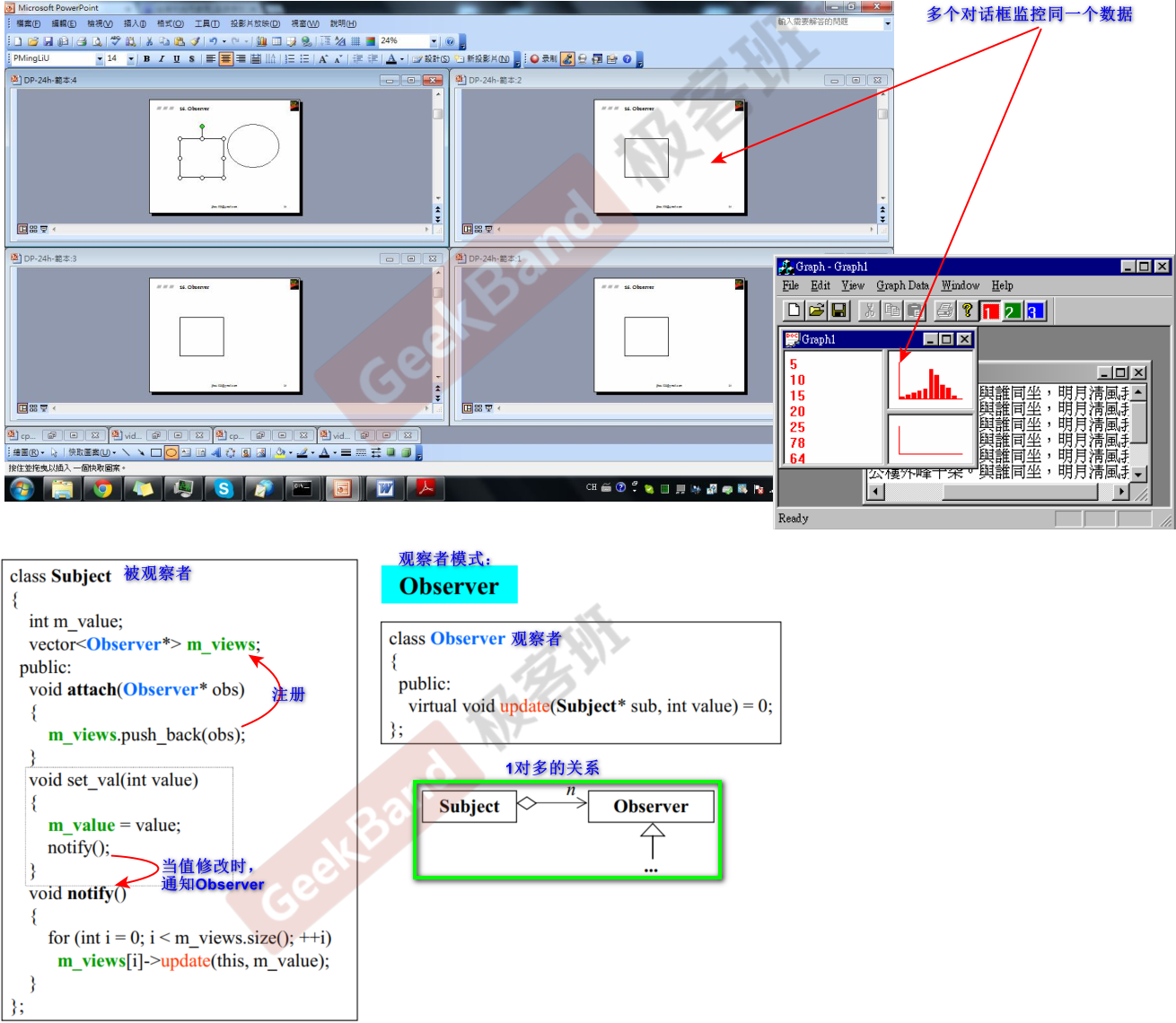
-
通过attach()将Observer对象注册到Subject对象中;
-
在外部调用set_val()修改值的同时,通知各个观察者;
d.组合模式(Composite)【Deletation+Inheritance】
- 将继承和委托搭配起来使用
理解:设想一下Linux中文件和目录的设计,目录也是一种文件,同时是一种容器,可以存放文件,也可以存放目录。那么该如何抽象出同时存放文件(Primitive)和目录(Composite)的文件系统类呢?
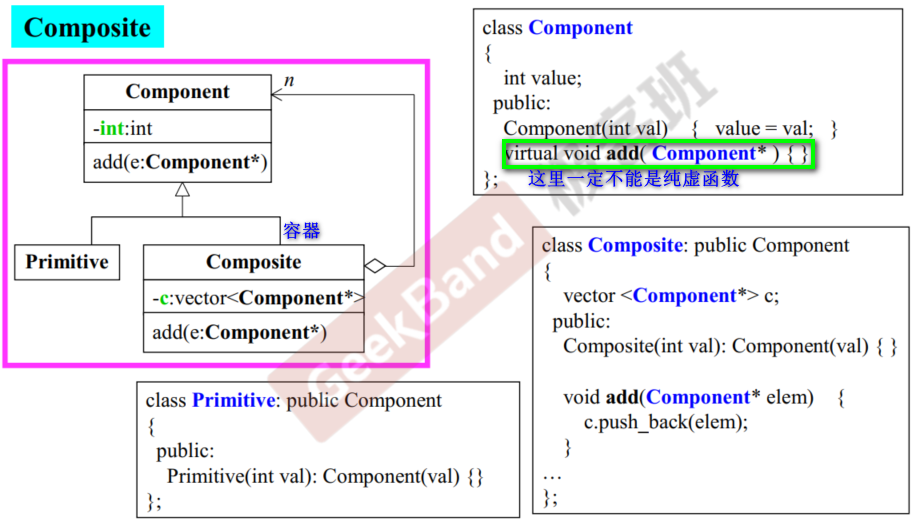
e.原型模式/克隆模式(Prototype)【Deletation+Inheritance】
场景:当父类(提前创建好的)需要一个继承体系并且需要【未来】才能创建子类:这样父类是不知道未来的子类是什么【即class name还没有出现】,父类不能使用new来创建子类,那该怎么实现呢?
-
先让子类创建自身生成原型,再让父类看到子类,最后复制子类,这样就相当于创建了。
-
当子类创建好后,父类如何才能看到呢?
- 需要由父类创建好空间,由子类将创建好的对象放上去,放上去之后就属于上边的空间,父类就可以看到了
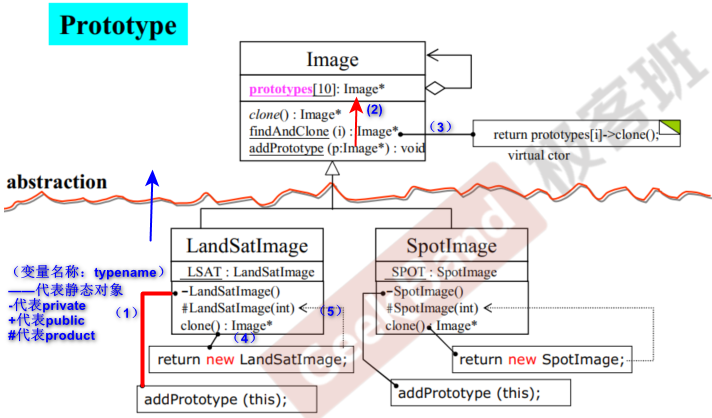
-
先调用
-LandSatImage()构造函数创建对象【原型】,在创建过程中,调用addPrototype()将对象放到父类空间,即将子类放到prototypes[10]中; -
通过放到父类的【原型】调用
findAndClone()遍历调用clone()在创建对象作出副本;
思考: 如果没有【原型】,是否可以将clone()设为静态函数创建对象呢?
- 不行,因为通过静态函数创建对象,需要class name,这里获取不到class name;
- 在
clone()中是通过#LandSatImage(int)构造函数创建对象的:-LandSatImage()这个构造函数是创建【原型】的,并且这两个构造函数是通过参数int区别的。





